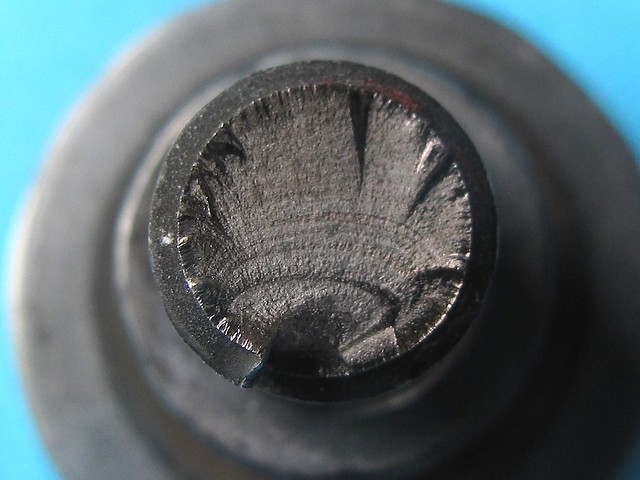Bolt upright
May 12, 2012 at 11:20 PM by Dr. Drang
Yesterday, my older son mowed the lawn, and I helped him bag the clippings (we’d gone too long since the last mowing to be able to use the mower’s mulching feature). Late in the process, I noticed half a bolt lying near the edge of the sidewalk. I poked around in the grass nearby, looking for the other half. No luck. I guess the mower blade will find it sooner or later.
The bolt is one of the four shoulder bolts that connect the bottom of the mower’s handle to its deck. The handle was a little floppy with only three bolts, but my son managed to finish the lawn anyway.
As you can see, the bolt fractured in the first thread, right next to the unthreaded part of the shank. This is a pretty common place for bolts to fail, as the threads create a stress concentration, and the first thread is typically where that concentration is the greatest.
Flipping the half-bolt up to look at the fracture surface, we see a classic fatigue failure. Fatigue is the gradual accumulation of damage under repeated loads.
In this photo, the origin of the fracture is at the bottom. It grew upward through at least half the cross-section, leaving behind the concentric arcs known as beach marks. This growth occurred slowly as the load on the bolt was applied and released, applied and released, applied and released. The beach marks represent the edge of the crack front at various points in its growth history.
The upper half of the fracture surface doesn’t appear to have beach marks, but it’s possible that there was fatigue crack growth in that zone, too. I’d have to look at the bolt under a microscope to be sure.
This fracture surface has another interesting feature that’s common in bolt failures: the radial lines that run inward from the outer edge of the bolt. This comes from the struggle between two tendencies of cracks:
- They like to run flat in a plane.
- They like to run through the weakest part.
The weakest part of a bolt is through the root (the bottom of the valley) of the thread. Because the root runs around the outer edge of the bolt in a helix, the crack can’t be planar and run through the root. It compromises by making little jumps—and occasionally big jumps—at the outside edge. The result is a sort of spiral staircase of cracks running around the helix of the thread root. If you were to shrink down
Because of the particular geometry of the shoulder, I can’t get replacement bolts at the local hardware store. Luckily, there’s a lawn mower specialty store one town over that has most replacement parts in stock. After a quick look through the parts manual, I’ll be giving them a call Monday.
Update 5/14/12
You know, if I were more like a real blogger, I would’ve linked to my earlier posts on fatigue. Two of those posts have photos of other items in my house that failed through fatigue: the plastic flushing arm from a toilet, and the oil-tempered steel torsion spring from the garage door.


